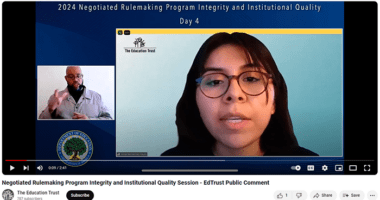Stop Fighting Over Pell and Start Delivering on Its Promise
In March, the Trump administration released its “skinny budget” — essentially its wish list for the government’s funding for fiscal year 2018, which begins Oct. 1. Congress will use this as a starting point, but it has the ultimate responsibility to pass a budget for the president to sign. This proposal is troubling for many reasons — not least of which is its devastating cuts to several education programs, including the Pell Grant and teacher development and support, as well as an ill-advised push to divert resources from the highest need K-12 schools. Over the coming weeks, in a series of blog posts, we’ll look at these proposed cuts and the harm they’d do to low-income students and students of color. And we’ll talk about the investments Congress should be making to promote opportunity and achievement for all students. Here’s the first installment.
For me, the Pell Grant was more than just money.
It was a savior — covering a portion of my college expenses that if left unmet may have made it impossible for me to go to college.
It was an opportunity — to go to my top choice, a university out of state, to learn from people from all over the world.
And it was a launching pad — to a college degree (the first in my family), which propelled me into a career that has taken me across the country and abroad.
For nearly 8 million Pell recipients today, the grant represents all of these things and more — a testament to Sen. Claiborne Pell’s intention to extend higher education opportunities to more financially needy students. Since then, the share of low-income students going to college has doubled, creating the types of launching pads that grow Americans out of poverty and into a middle-class, self-sustaining workforce.
But lawmakers, as of late, seem to have lost sight of that. Almost yearly, advocates have to fight for the importance and value of Pell, for the preservation of the maximum award, and for the protection of its reserves — sometimes, successfully; other times, for naught. Six years ago, Congress eliminated year-round Pell, hampering students’ abilities to attend college over the summer. This year, proposed cuts will go after Pell’s reserves, decimating its future stability and commitment to students.
These aren’t the battles we should be having; they undermine the Pell Grant program and Sen. Pell’s hopes for it to be someone’s savior or another person’s opportunity. When it was established in 1972, the Pell Grant covered more than three-quarters of the average cost of tuition at a public, four-year college; today, it covers less than one-third, leaving students — much like I did — juggling some combination of loans and full-time work to pay for the rest.
I imagine Sen. Pell shaking his head. It’s a shameful testament to how Congress views opportunity in higher education, and it’s a shameful tribute to Pell’s legacy.
Congress should stop its fighting over cutting dollars and cents and start investing in creating opportunities and dreams.
Photo credit: Kentucky Center for Economic Policy












